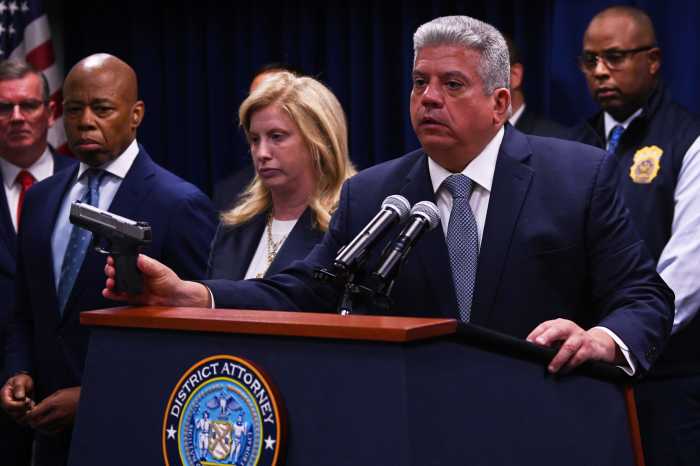-

Photo Credit: iStock -

Photo Credit: iStock -

Photo Credit: iStock -

Photo Credit: iStock
New Yorkers put up with a lot. Scam attempts are just one more.
Con artists looking to make a quick buck are constantly reinventing their tale, but as police try to cut down on those that threaten the feeling of safety in the city, experts say the best line of defense is simply awareness of the game. The ever-rotating selection of scams, like hawking fake tickets or the broken bottle play, are engineered to intimidate and trick until the public and law enforcement becomes the wiser.
“It’s definitely difficult,” said Captain Christopher Flanagan, the commanding officer of the NYPD’s financial crimes task force. “A scam might work the first time and then it gets reported.”
Nick Camp, 29, was walking down 110th Street in the spring of 2006 when he and a friend — like many others before and since — walked right into the broken bottle scam.
After bumping into a man on 110th Street, Camp and his friend kept on walking. But he was quickly called back.
“He said, ‘hey, you broke that. That was medicine. I need that,’” Camp, a Columbia freshman at the time, recalled. “This guy was like, walk with me across town and buy me more medicine. Of course we didn’t want to do that. We were already sort of nervous.
“I had flip flops on so running wasn’t an option,” he added. “So we just kind of went along.”
Earlier this month, Police Commissioner Bill Bratton said the department would crack down on con artists selling fake tickets to Liberty Island and the Staten Island Ferry, which have become an increasingly common way to scam people out of their money.
Speaking on “The John Gambling Show” on AM 970, Bratton said he will add a permanent detail down by Battery Park, like exists in Times Square.
But Bratton said the NYPD needs the public to do their part.
“But the public really needs to be mindful of the potential to be scammed,” he said. “To the best of our ability, we try to deter that.”
Flanagan said the department’s grand larceny division is constantly reviewing complaint reports, looking for patterns to warn New Yorkers.
But experts said the pattern doesn’t always hold.
“The nature of the scams change all the time,” said Robert McCrie, a John Jay professor with an expertise in security management. “Just like three card monte plays its phase out, there are new variations that come along all the time. And that’s why fraudsters are able to operate with them successfully for a period.” The underreporting of these scams, which don’t often generate a lot of money per victim, makes it harder to combat them. Joseph Giacalone, a retired NYPD detective who lectures at John Jay College of Criminal Justice, said it’s only easy for police to nip a scam in the bud if they have the data to go along with it.
“Like a lot of things in New York City, we put up with a lot of stuff,” Giacalone said. “They’re going to keep on going until you stop them.”
Indeed, after the scam artist led Camp and his friend to an ATM to hand over $40, the pair never reported it. In this case, the story involved breaking medicine for the man’s unborn baby.
“There was probably many things we could have done, but all the social influences were pushing us to sort of go along with it,” said Camp, who is now working on his Ph.D. in social psychology at Stanford, studying police-community relations. “First, I didn’t experience any physical harm. Second, I would say, we didn’t feel like victims — we just felt sort of dumb. And we felt like we didn’t really have anyone to blame but ourselves.”
His friend, Francis Bartus, agreed, not wanting to let go of the however-small hope that the man had been telling the truth.
“I didn’t walk away feeling like I had been assaulted,” said Bartus, now 29 and living in Bedford Stuyvesant. “I didn’t want to admit to myself that I had been had, that I had in fact been scammed.”
Ridgewood resident David Gassaway, 44, was scammed twice by the same man: once when he first moved to the city in 1994 and a second time a few years later.
Gassaway, who was living on the Lower East Side when he first moved, was trying to navigate the city (having gotten on the wrong train) and was in Chinatown when a man approached him and pretended to know him.
The man then claimed to need some money to save his broken-down car from being towed which, he said, he needed to visit his mother in the hospital. Gassaway, feeling guilty, forked over the only cash he had, $3.
“I thought, ‘you’ve had a New York experience. It wasn’t that expensive,’” Gassaway said. “I was a little angry at him, a little angry at myself, feeling like a rube.”
Gassaway ran into the man again a few years later — with the exact same story.
“The crazy thing is: the last time I saw you, the exact same thing happened to you,” he recalled telling the man. “He basically just fled because he had been busted.”
These scams are only a few of the many that con-artists come up with on a regular basis.
Flanagan said popular ruses include slashing someone’s tires as they come out of the bank and then, after they get back in the car, pointing it out and offering to help them fix it, while someone else grabs their bag from the passenger seat. Another tends to target elderly people by offering them a cut of some “found money” as long as they contribute to the pot.
“They’ll talk the person into putting some of their own money in and then hand them the bag of ‘found money.’ And it turns out to be cut up newspaper,” he said. “They’ll have money there, but they’re doing a switch — like a bait and switch.”
While police are constantly looking out for evolving trends, it’s often up to the victim to prevent this from happening to them, McCrie said.
“If a person quickly is drawn into this interaction with the fraudster, it’s hard to extricate themselves,” he said. “They could say: ‘well look, I really don’t feel that I owe you anything, but there is a precinct station just four blocks away. Let’s go there and explain it to the desk sergeant.’”
Here are the top five scams to look out for:




























